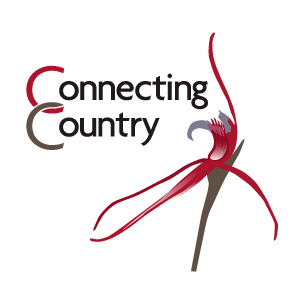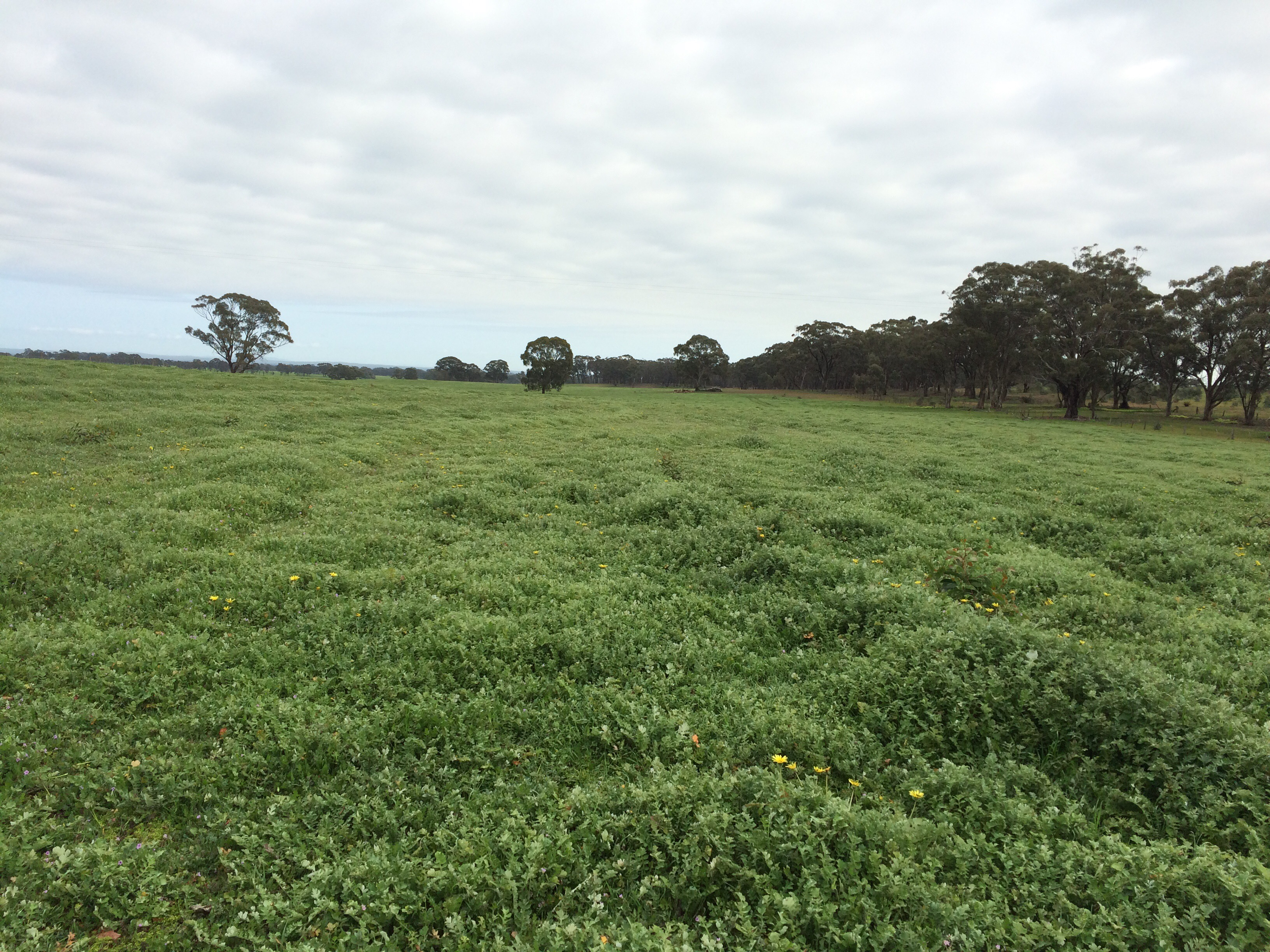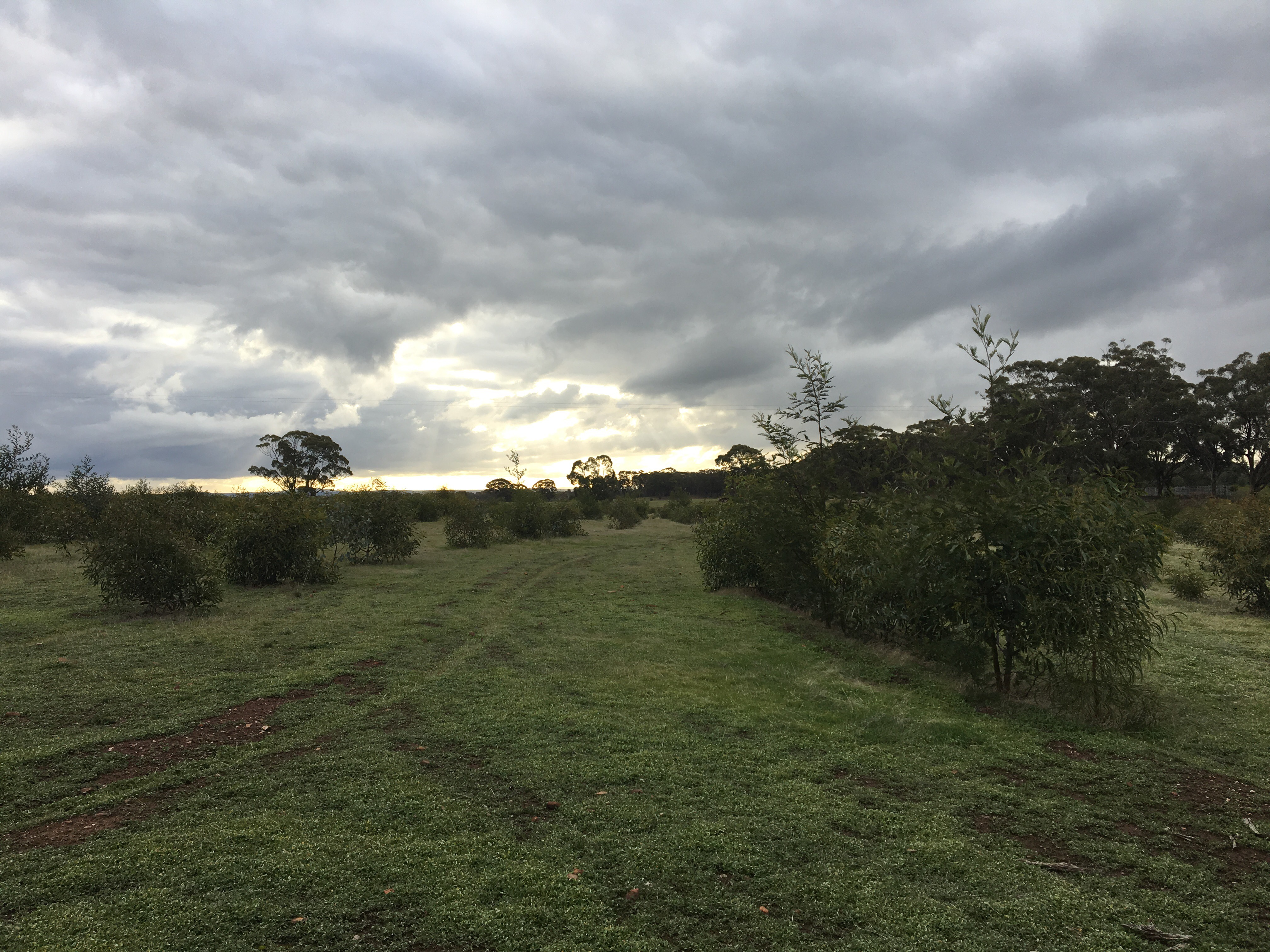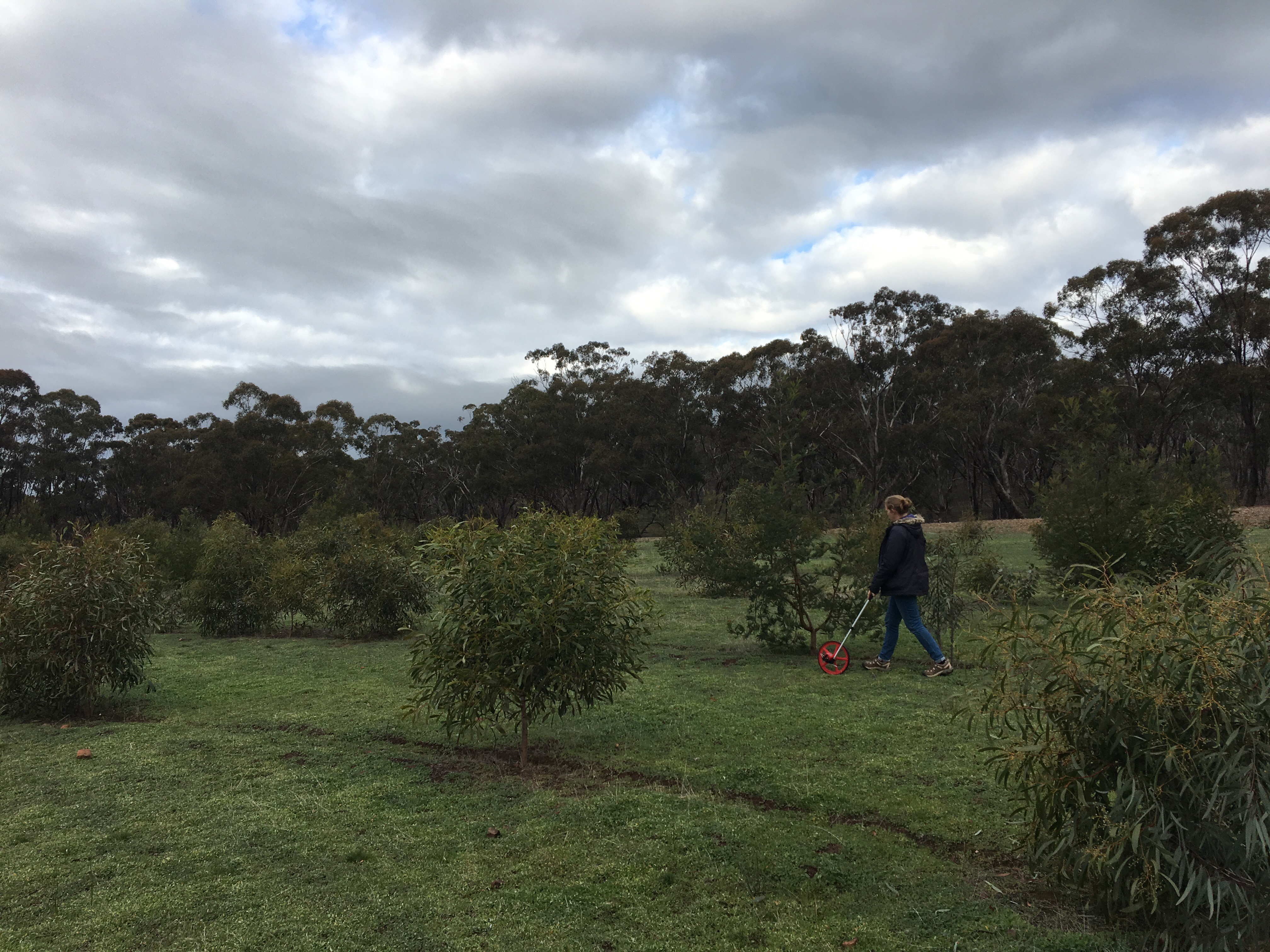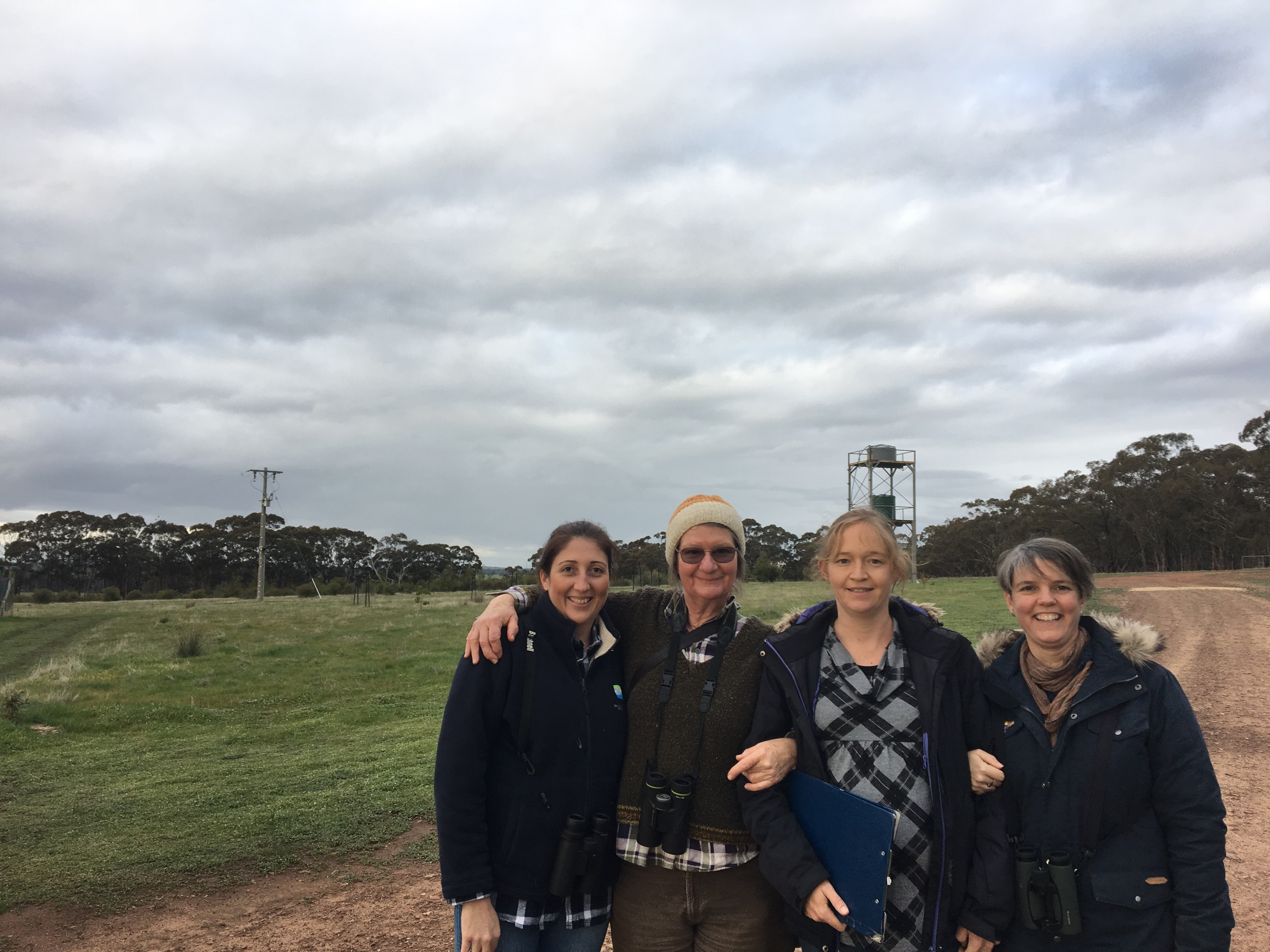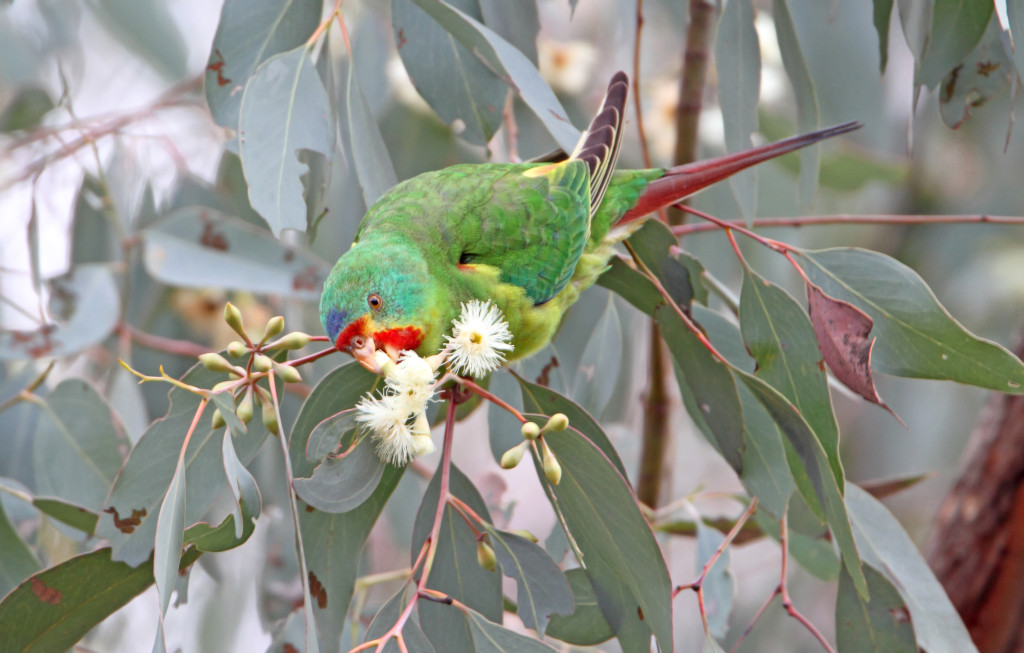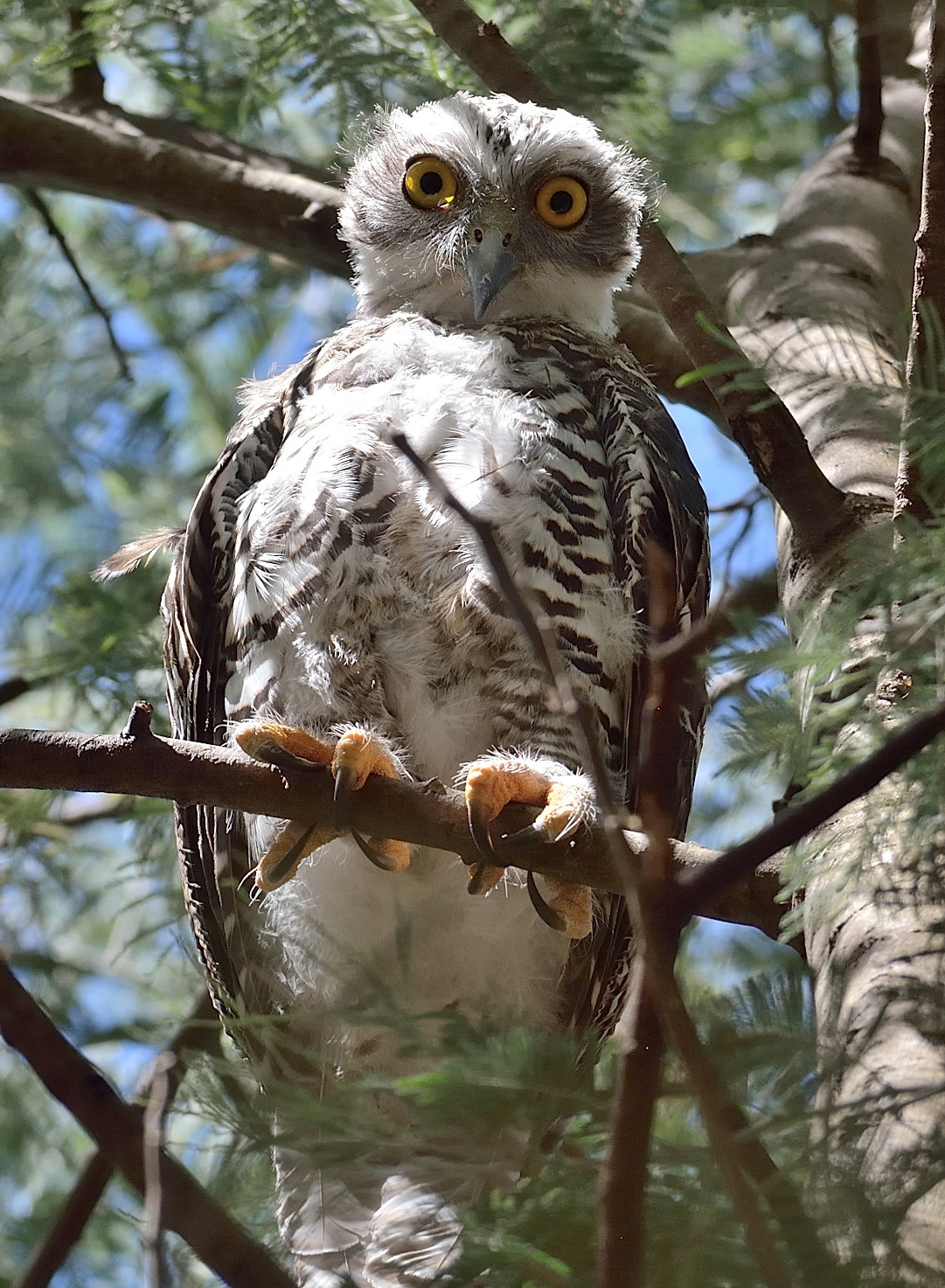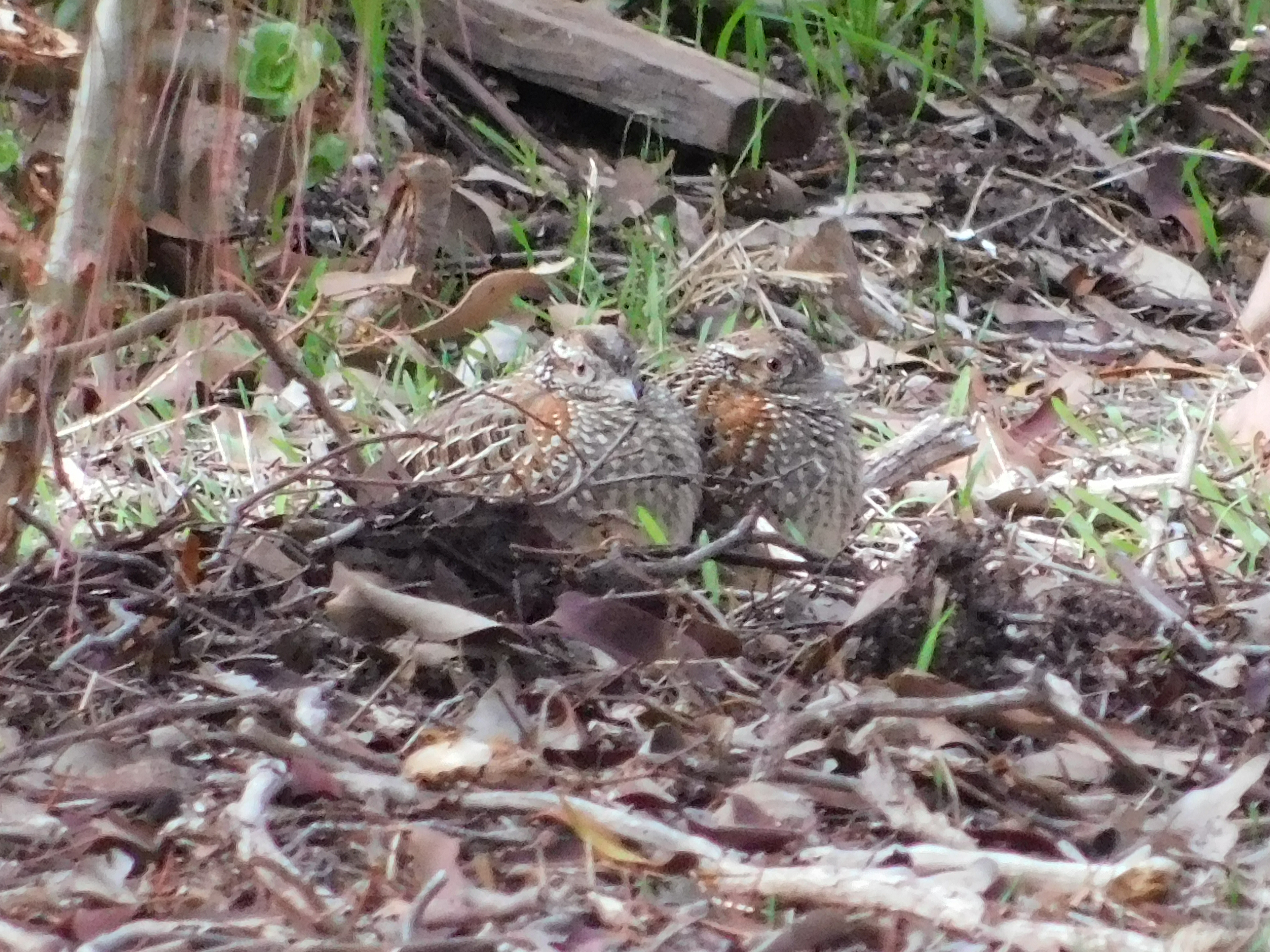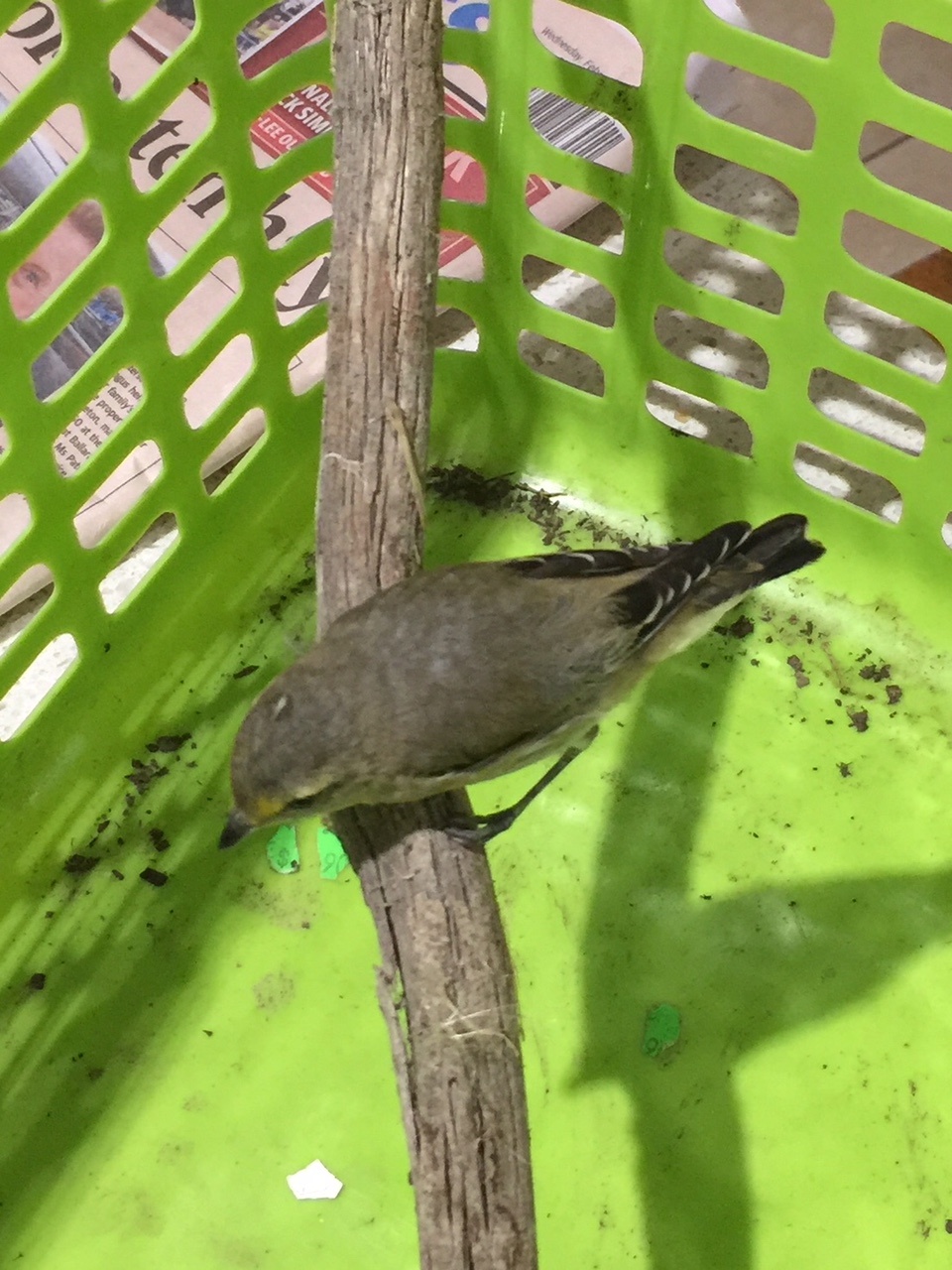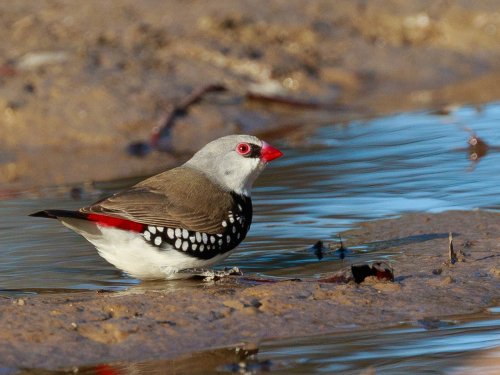Habitat Health Check – our new project!
Posted on 7 August, 2018 by Tanya Loos
In 2009, Connecting Country created a Biodiversity Blueprint with the help of the community and our partners. From the outset, scientific monitoring has been a high priority at Connecting Country. Without monitoring, we don’t know if we’re achieving our goal to restore habitat for native species.
Monitoring achievements
We’ve been fortunate to have a world-class landscape ecologist, Professor Andrew Bennett, assist in creating our monitoring programs for woodland birds and Brush-tailed phascogales. As of 2018 we’ve collected 23,996 individual bird records, and 1,424 records for our phascogale monitoring.
Our wonderful ‘Connecting Landscapes’ project (2013- 2017) worked with local landholders to help restore over 1,600 hectares of land. It also funded staff to establish and run our bird and nest box monitoring programs. These days, funding is more likely to be smaller amounts of money over shorter time scales. In-house monitoring by staff has become a luxury!
In the meantime, we’ve developed a team of highly-skilled and enthusiastic volunteers ready to take a more active role as ‘citizen scientists’. We’re poised to update to a new model that is more community-driven – drawing upon the power of YOU, the community, to contribute data as volunteer citizen scientists.
This change has been in the air for a while. After the success of our ‘Stewards for Woodland Birds’ project, we’re delighted to announce we have funding from the Helen Macpherson Smith Trust to support this important transition.
The new project is ‘Habitat Health Check: empowering citizen scientists to monitor habitat health in Central Victoria.’

Male Hooded Robin. Analysis of our results shows a welcome increase of this species in the Mount Alexander region. Photo by Geoff Park.
Habitat Health Check – analysing and acting on our scientific monitoring
Habitat Health Check is a collaborative, robust, citizen science project that monitors native animals and plants in the Mount Alexander region. We will review our existing, long-term monitoring programs, and move to a new collaborative, targeted model that empowers our enthusiastic and skilled volunteers, improves scientific rigour, and promotes data sharing via the Visualising Victoria’s Biodiversity online portal.
Tanya Loos, Connecting Country’s monitoring and engagement coordinator, will deliver the project between now and 2020. Habitat Health Check will encompass BirdWatch, NestboxWatch, FrogandReptileWatch and PlantWatch.
Some expected highlights
Our scientific data will be analysed by experts from BirdLife Australia and Latrobe University, and the results shared in an exciting evening forum.
Four workshops will review our data and results, and invite the community to explore new scientific questions and methods. How can we best work with the new BirdLife Castlemaine District group? What have we learned in the past eight years? And where to from here?
We’ll collaborate closely with SWIFFT – the State-wide Integrated Flora and Fauna Teams, to share our findings and use this great online resource.
In 2019, we’ll run a competition for the best local photographs of our favourite flora and fauna, for Connecting Country’s very first calendar!
Get ready to get involved
We will be recruiting team leaders to inform and guide our various citizen science programs – so birders, nestbox enthusiasts, plant nuts, reptile watchers and froggers: watch this space!
Small bush bird habitat created at Bradford!
Posted on 30 July, 2018 by Tanya Loos
What a difference a couple of years makes! Last Thursday, 26 July 2018, Bonnie, Frances and Tanya had the great pleasure of visiting Kerri Peacoulakis’ property in Bradford to marvel at the growth of native plant species at their direct seeding site, and also chat about bird surveying. Below is a photo of part of the site taken in September 2016, about one year after direct seeding.
Below is the same site, taken in the same direction. Note the large eucalypt with the wide crown in the left hand side of the photo.
The site was direct seeded in 2015, as part of Connecting Country’s Habitat for Bush Birds project. It is amazing to think that there are many tiny young plants fighting for survival under all the prolific capeweed in the first photo! The site is a bird survey site called NW-PR-03, a northwest paddock revegetation site. The direct seeding is even more successful looking in the other direction, towards the Blue Hills area.
In the above photo, Bonnie is using a trundle wheel and a counter to carry out a direct seeding success count. These counts measure how many plants have grown, giving a standard measure of trees/shrubs per metre count. This number is comparable from site to site, and enables us here at Connecting Country to monitor the growth of our direct seeding from year to year.
The plant species in the direct seeding included a mix of local wattles, eucalypts, she-oaks, hop bush, and hakeas.
Kerri is taking on the bird survey site, by surveying the site four times per year. During our visit, we conducted a 20 minute 2 hectare count, with Kerri entering the data on her Birdata app on her smartphone. So simple! During the survey, we saw many open country species such as Red-rumped parrots, Welcome swallows and Australian magpies. Kerri said that she had observed Superb fairy-wrens on the site – a true mark of success as these little birds are NEVER recorded in a bare, open paddock! Well done Kerri and also her partner Tusker and family for a fantastic project!
BirdLife Castlemaine District launch and Swift Parrot conservation
Posted on 10 July, 2018 by Tanya Loos
Many excited faces gathered at the Castlemaine Botanic Gardens Tearooms on Saturday 7 July 2018, as we celebrated the launch of BirdLife Australia’s newest branch – BirdLife Castlemaine and District. The launch also incorporated an ‘Act for Birds’ Roadshow – a community forum on how we can encourage stronger environmental laws to help safeguard threatened species such as the Swift Parrot.
We began the afternoon with a Welcome to Country from Uncle Rick and Kane, and Uncle Rick talked about the significance of birds to the Dja Dja Wurrung. Fiona Blandford (Branch Network manager) and Jane Rusden (BirdLife District Convenor) formally launched the new branch, with a lovely nod to Connecting Country and our work to build community interest in birds on our region.
Brendan Sydes (Connecting Country president), in his role as lawyer and CEO of Environmental Justice Australia, gave a rousing introduction to the potential for positive change to environmental laws in this country.
Beth Mellick (of Wettenhall Environment Trust) is the regional coordinator for the local Swift Parrot counts done twice a year. Beth gave a wonderful talk on our local swifties and the power of citizen scientists, including showing an excerpt from Debbie Worland’s DVD, the Swift Parrots of Muckleford in Central Victoria. The DVD shows never-seen footage of Swift Parrots filmed entirely in Muckleford over a five-year period by Debbie Worland, a member of the Castlemaine Field Naturalists Club. For infomation about the DVD, email swiftparrotsofmuckleford@hotmail.com. If you would like to be involved in the Swift Parrot count later this year, email Beth at beth@wettenhall.org.au.
We then heard from our main speaker – Kim Garrett (Conservation Community Organiser for BirdLife Australia). Kim spoke passionately and eloquently on how our current laws are failing threatened species in Australia, and what we as community members can do about it. Many policy and environmental law experts have prepared a detailed case for how environmental laws could be strengthened in our country, and the Act for Birds campaign summarises the case succinctly.
In a nutshell, the campaign calls for us to:
- Create national environment laws that genuinely protect our unique birdlife.
- Establish independent institutions that set national environmental standards, and operate transparently and independently of government.
- Guarantee community rights and participation in environmental decision-making.
To get involved, head on over to www.actforbirds.org to sign the petition and get some tips on engaging with your local member.
The Swift Parrot is Critically Endangered and numbers are still declining due to serious loopholes in current environmental laws. The current laws are up for a twenty year review, so now is an ideal time to act.
Please enjoy this gallery of photos of some of the attendees. Many thanks to the staff from BirdLife for travelling to Castlemaine to share in the excitement, to the committee and volunteers of BirdLife District Castlemaine for planning and logistics, Uncle Rick and Kane, the presenters, and to Jane Rusden for pulling the whole event together!
The contact email for the new branch is castlemaine@birdlife.org.au and our new Facebook page is BirdLife-Castlemaine-District
For a great overview of the Swift Parrot and the ‘Act for Birds’ campaign, see this article in the Bendigo Advertisor: renewed-focus-to-save-castlemaines-migratory-parrots/
BirdLife Celebration and Roadshow – 7 July 2018
Posted on 28 June, 2018 by Frances
BirdLife is coming to town, so put 12:30 – 3:00 pm on Saturday 7 July in your diaries folks. Join us at the Tearoom in Castlemaine Botanic Gardens (2 Walker Street, Castlemaine VIC). There will be celebrations, information on how we, the grassroots, can really make a difference, and an art activity for the kids.
BirdLife is bring its ‘Act for Birds’ Roadshow to Castlemaine, with plenty of ideas on how you and I can make a real difference for the natural environment.
The stunning Swift Parrot needs our help to save it from extinction. (Photo by Chris Tzaros)
Drum roll please …… We have a new group in the area: Castlemaine District BirdLife Branch, for all bird enthusiasts and aspiring bird enthusiasts, as well as those who are just curious or like birds a little bit. On offer will be monthly bird outings, some talks and a chance to meet like-minded people, across all age groups. Come along, find out more and meet some of us.
Jane Rusden, Convener Castlemaine District BirdLife Group
Powerful Owl Chat – Thursday 28 June 2018
Posted on 19 June, 2018 by Tanya Loos
Come along and share stories about Powerful Owls at a ‘Powerful Owl Chat’ in Maldon.
Garry Cheers will tell us about Powerful Owl food, habitat, breeding, behaviour and giving owls space during breeding season. Geoff Park will show owl images and talk about what you can do to connect with your local environment.
Bring along your photos and owl knowledge to share. There will be plenty of opportunity to ask questions and share observations. All welcome.
Thursday 28 June 2018 from 7.00 – 8.30 pm
Maldon Neighbourhood Centre (1 Church St, Maldon VIC)
For inquiries please contact Forest Keegel on 0402 035 521 or forestkeegel@gmail.com
Makarrata Garden Tarrangower MaGaTa is happening on Dja Dja Wurrung Country in Maldon. It’s a a community engaged sculpture project to research habitat of Powerful Owl and Duan (Brush Tailed Phascogale), and educate ourselves about the history of Dja Dja Wurrung people and celebrate their living Culture.
Painted Button-quails in the garden
Posted on 29 May, 2018 by Tanya Loos
Connecting Country staff member Bonnie Humphreys has seen small, quail-like birds wandering around her garden for weeks, even on her doorstep. Until now, they’ve escaped Bonnie’s efforts to capture a photo and confirm identification as Painted Button-quail! The two birds seen here were resting quietly together.
Button-quails are a truly Australian group of birds. Although they look a lot like quails, DNA analysis suggests that button-quails are quite distant from all living groups of birds. Their behaviour is certainly very unusual!
Unlike most birds, it’s the brightly coloured female who calls, and attracts a male. They are polyandrous, with one female mating with several males in an area. After mating, the female builds a domed nest near the ground in a shrub or grass tussock, and lays three or four small white eggs. The male then incubates the young until hatching. Once hatched, the tiny little chicks fledge right away and the male feeds them for the next ten days or so. After this, the young button-quails can fend for themselves.
The birds pictured above could be either males, or immature birds. In females, the reddish patch is brighter. However, the depth of the colour red is quite variable according to light conditions and the position of the bird. Hence it’s quite tricky to identify the sex of the bird. (Happy to hear local birder expert opinion on this one!)
Bonnie’s visiting button-quails are a group of three birds, and the Handbook of Australian and New Zealand birds says they are most often seen in small family groups. At this time of year, breeding has finished, so maybe they are just being companionable and foraging together until the female starts her ‘booming’call.
Their foraging technique is also most unusual. Painted button-quails often feed in pairs, in grasses and leaf litter on the ground. They scratch and glean, spinning on alternate legs to create distinctive circular depressions, known as platelets. Platelets are often the only visible sign that the bird is present. The photo below shows the typical look of platelets in bushland with plenty of leaf litter.
There’s been extensive feeding activity in leaf litter and lawn areas at Bonnie’s place. It was hard to capture on camera the sheer extent of the ground being worked over by these enthusiastic little birds.
Painted button-quails are a member of the threatened Victorian Temperate Woodland bird Community. They are notoriously difficult to capture during typical (20 minute, 2 ha) bird surveys, so we welcome any sightings and observations. You can download a sightings sheet here, and let us know where and when you’ve seen button-quails, or their platelets.![]()
In 2011, Echidna Walkabout Tours captured this amazing footage of a Painted Button-quail foraging in leaf litter in urban Port Melbourne! Do watch the whole video because at the end the female puffs herself up like a frog and starts calling her booming call. The low frequency call is difficult to hear on the video, but you can see the amazing behaviour!
Eastern Yellow Robin Talk – Thursday 31 May 2018
Posted on 16 May, 2018 by Tanya Loos
All are welcome to join Lana Austin of Monash University in Newstead next week as she unpacks the bizarre genetic story of what is known (and not known) about the Eastern Yellow Robin. Lana will also explain how volunteers can participate in this fascinating genetic study.
When: Thursday 31 May, 2018 at 7 pm
Where: Newstead Community Centre: the Mechanics Hall (Lyons St, Newstead VIC)
This is a free event, with no need to book!
We featured the Eastern Yellow Robin project on the blog last week – read the story here if you missed it. And click here for a poster about the event.
Caught on camera!
Posted on 10 May, 2018 by Tanya Loos
This remarkable photograph shows a Yellow-footed Antechinus bounding up a log with an Australian Magpie in hot pursuit. It was taken by a trail camera – amazing timing!
In this case, the antechinus escaped being breakfast, running so fast all of its paws are in the air! It is great to see the tables turned on these adorable but voracious hunters (see pictures of a Yellow-footed Antechinus preying upon a grey fantail here).
The landholders who sent us the photo said ‘These wildlife cameras are great! We catch so much and are able to watch so many different animals, birds, reptiles, insects, etc. and what they get up to each day.’ Lynne and Ric live on a beautiful woodland property east of Maldon, and are keen bird surveyors.
If you would like to see what lives on your property, why not borrow a wildlife camera from us? We are happy to loan wildlife cameras to our members – usually for a three week period. To book one, email tanya@connectingcountry.org.au or phone us at the office on 5472 1594.
Many thanks to Lynne and Ric for the amazing photo.
Swift Parrot surveys on 19 and 20 May 2018
Posted on 10 May, 2018 by Tanya Loos
Swift Parrot survey season is upon us again, with a monitoring weekend coming up on 19 and 20 May. BirdLife Australia’s Swift Parrot monitoring program is essential for assessing where our beloved swifties are, what resources they are feeding upon, and their numbers.
Our regional coordinator for swift parrot surveys is Beth Mellick from Wettenhall Environment Trust. If you would like to be involved in this Autumn’s swift parrot count, contact Beth via email to be assigned a site (email: beth@wettenhall.org.au). And regular watchers – don’t forget to let Beth know where you are surveying so we can make sure we cover our whole region!
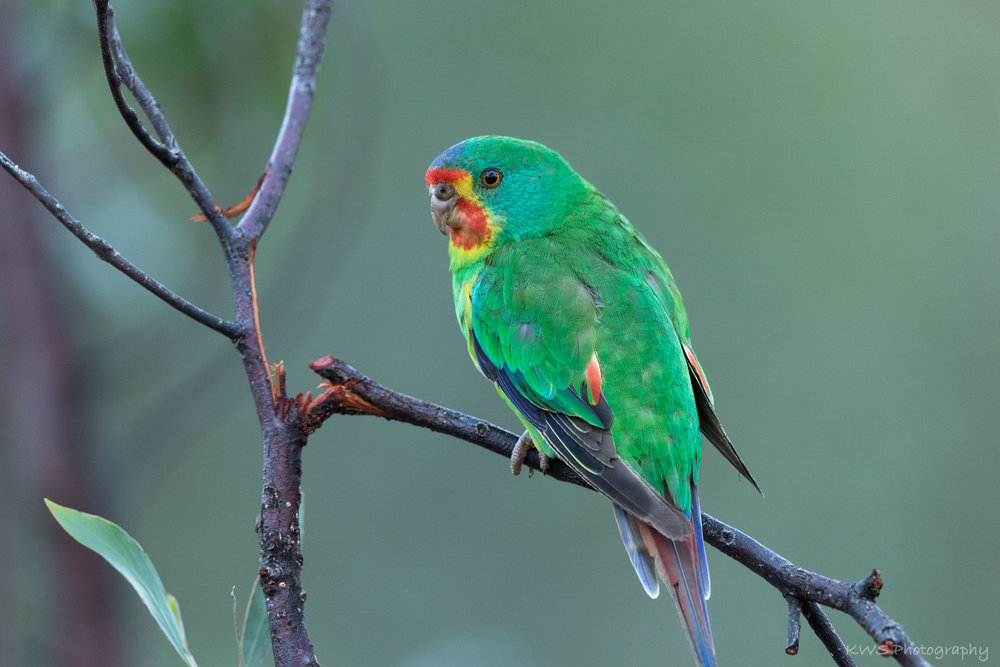
This beautiful Swift Parrot was photographed by Connecting Country member Micheal Gooch, visiting his bird bath in Clunes (www.outsidefourwalls.com)
Chris Timewell (formerly of Connecting Country and now with BirdLife Australia) provided this update on Swift Parrot (and Regent Honeyeater) surveys:
We are again seeking volunteers to search for both species across Victoria, NSW, ACT and Queensland, as Swift Parrots make their way up to the mainland from Tasmania and Regent Honeyeaters move about the landscape in search of flowering Eucalypt trees to feed on. The May 2018 Swift Parrot and Regent Honeyeater survey weekend is coming up soon on May 19th and 20th. As always, we are happy for people to undertake their searches up to a week on either side of the survey weekend. Opportunistic sightings from any time of the year are also welcomed.
So far this season there have been scattered Swift Parrot sightings from across its mainland range – with the highest clusters around the north-eastern fringes of metropolitan Melbourne and returning birds to favourite haunts such as Mt Majura (ACT) and the Cessnock forests of the Lower Hunter (NSW). There are Spotted Gums noted flowering on the South Coast of NSW (e.g., Marramarra National Park), Coastal Grey Box is flowering in the Lower Hunter and Swamp Mahogany is starting to flower in coastal areas – each of which are attracting large number of lorikeets and other nectar-feeders.
If you are new to the plight of this Critically Endangered parrot, the BirdLife website has a profile on swift parrots here.
Eastern Yellow Robin – more than meets the eye!
Posted on 2 May, 2018 by Tanya Loos
Monash University is conducting an amazing study on the genetics of a local woodland bird, the Eastern yellow robin right here on our doorstep in the Muckleford and Newstead forests. Lana Austin from Monash University is living in the Newstead area and coordinating volunteers for mist netting of Eastern yellow robins, and wild observation of banded robins. Lana introduces the project below.
 Information evening and local bird banding project
Information evening and local bird banding project
Eastern yellow robins. A common woodland species. Not endangered. No fancy breeding displays. Easy to spot. So why is Monash University putting so much effort into following every move of these birds?
Well, it turns out they are more remarkable than once thought.
Recently we discovered two unexpected genetic lineages in our familiar robins. These lineages lie neatly to the east and west of the Great Dividing Range. While they are genetically distinct, even with the best pair of Swarovski binoculars the two lineages look exactly the same to the human eye.
Here’s where it gets really interesting. Along the east and west boundary there are sites where the two genetic lineages coexist (e.g., Muckleford State Forest, Crusoe Reservoir, Bendigo). So, they are hanging out together but maintaining ‘genetic purity’. This means that while we can’t see the difference, the birds can.
We are witnessing the Eastern yellow robins split into two species!
This raises some interesting questions. How do the robins know that a potential mate is the same genetic lineage? What happens when they mate with a different lineage? Would they prefer to mate with a different lineage, or not at all? How successful are the hybrid offspring?
Later in May (date being finalised), Lana will be giving a presentation as she unpacks what is known (and not known) about the Eastern yellow robin. Volunteers are most welcome to join the field team from the 5-10 May on their colour banding project. Email lana.austin@monash.edu for more information.
For info on the Eastern Yellow Robin Project website click here
Birdata app and portal – an exciting new step
Posted on 19 April, 2018 by Tanya Loos
Recording bird surveys has just become much easier for a lot of keen bird people in our local area! Last Friday (13 April), over 20 bird survey volunteers gathered at the Castlemaine Botanical Gardens Tea Rooms to hear about BirdLife Australia’s smartphone app and bird data website.
Andrew Silcocks from BirdLife Australia manages the Bird Atlas – a comprehensive map of the distribution and numbers of Australian birds. Over the course of three very enjoyable hours, we learned how our data collection helps in bird conservation, how to use the very user-friendly app, and how to examine bird information on the portal known at Birdata.
And we were all very happy to hear Chris Timewell, BirdLife Australia’s Woodland Bird Project Coordinator (formerly Director of Connecting Country), present on the Birds on Farms research project. A separate blog post about the Birds on Farms project will follow soon.
Connecting Country has been an affiliate organisation of BirdLife Australia since 2015. The two organisations are both bird mad (of course!), and collect and share bird data with one another. Connecting Country’s long term monitoring program has sent BirdLife over 20,000 individual records for their Birdata bird mapping project, and we have also extracted data from BirdLife to help with our reporting.
The Birdata app
The feedback from participants was wonderful! The app is surprisingly easy to use – the phone finds your location, then you give it a site name, add the survey information such as the type of survey, and then simply start counting birds! So for those of you who were unable to attend the workshop, the following comments may encourage you to visit the Birdata website, download the app and have a go!
‘Really clearly explained, and I found the app easy to use’
‘I used Birdata extensively up until about 2 years ago so this provided a valuable update’
‘I had never previously used this app but I now feel very confident to conduct and submit surveys’
‘Opened my eyes to the power of the app AND the portal’.
To download the app click here. In the help section of the Birdata website here, there are short instructional YouTube videos and printed information on the portal and the app. These also might be useful for those of you who attended the workshop and would like a refresher.
The Birdata portal
The Birdata website is referred to as a portal. Once you are logged in, you can see your surveys and all your data. You can edit and change surveys you have done, such as correct a misidentified bird or refine the location.
You can also share your surveys with other people, such as on social media or by email. Any person doing bird surveys for one of our ‘official’ monitoring programs (such as the KBA monitoring, the Perkins surveys, or the Connecting Country sites) can send their data directly to BirdLife using the app if they wish. This saves on time and double handling. However, also emailing a copy of your surveys to us here at Connecting Country will help with keeping track of our bird survey program. Of course, those people who wish to stay with the old pen and paper method are most welcome to do so!
A fantastic feature of the portal is the ability to generate an up-to-the-minute bird list of any area of any size simply by drawing a polygon on the Birdata map. I used this function today to supply a bird list to Sutton Grange Landcare group. See the ‘Explore’ button on the portal for this feature.
Many many thanks to Andrew Silcocks for such an enjoyable and informative workshop! We would also like to thanks the Wettenhall Environment Trust for funding the workshop.
Volunteer with a flair for graphic design needed for bird project
Posted on 10 April, 2018 by Tanya Loos
Calling all graphic designers! We are looking for a volunteer to design two very special bird signs, which will be displayed permanently at Rise and Shine Bushland Reserve in Sandon, and at the Muckleford Nature Conservation Reserve. The signs will illustrate the values of the Muckleford and Strangways Key Biodiversity Areas (KBAs), and are a key component of our Caring for Key Biodiversity Areas project.
The trigger species for these areas are the Diamond Firetail, Swift Parrot and Flame Robin. KBAs are designated by BirdLife International and BirdLife Australia.
The Caring for Key Biodiversity Areas project involves an on-ground works component, bird surveys and the two interpretive signs.
Design of the signs would be an excellent project for a university student who is studying the visual arts, or a graphic designer who wishes to do some pro-bono work to contribute to the community while raising the profile of their business. Purchase of the signs will be covered by the grant, but we need help with the graphic design component as a volunteer contribution.
We will be able to supply the written content and quality photos of the target species to use on the signs. But the magic of their presentation is up to you!
The signs will be launched in September 2018, so ideally we would have the signs designed by the end of July.
If you are interested, please send a copy of your resume, business website or an example of your graphic design work to Tanya at Connecting Country: tanya@connectingcountry.org.au
We will make a decision and let people know on Monday April 16, so get your applications in quick!
And of course, feel free to call on 5472 1594 if you have any enquiries!
The Caring for Key Biodiversity Areas projects is funded by the Victorian Government – Community and Volunteer Action Grants.
‘Bush Play’ and ‘Cranes, Herons and Storks’ – two April 2018 events
Posted on 5 April, 2018 by Tanya Loos
Autumn is a busy time in Central Victoria. We would like to share two events that our readers may enjoy. ‘Bush Play’ is an activity especially for children, as part of Nature Play week. ‘Cranes, Herons and Storks’ is a presentation proudly hosted by Castlemaine Field Naturalists Club.
Bush Play: the colours of the bush in Kalimna Park
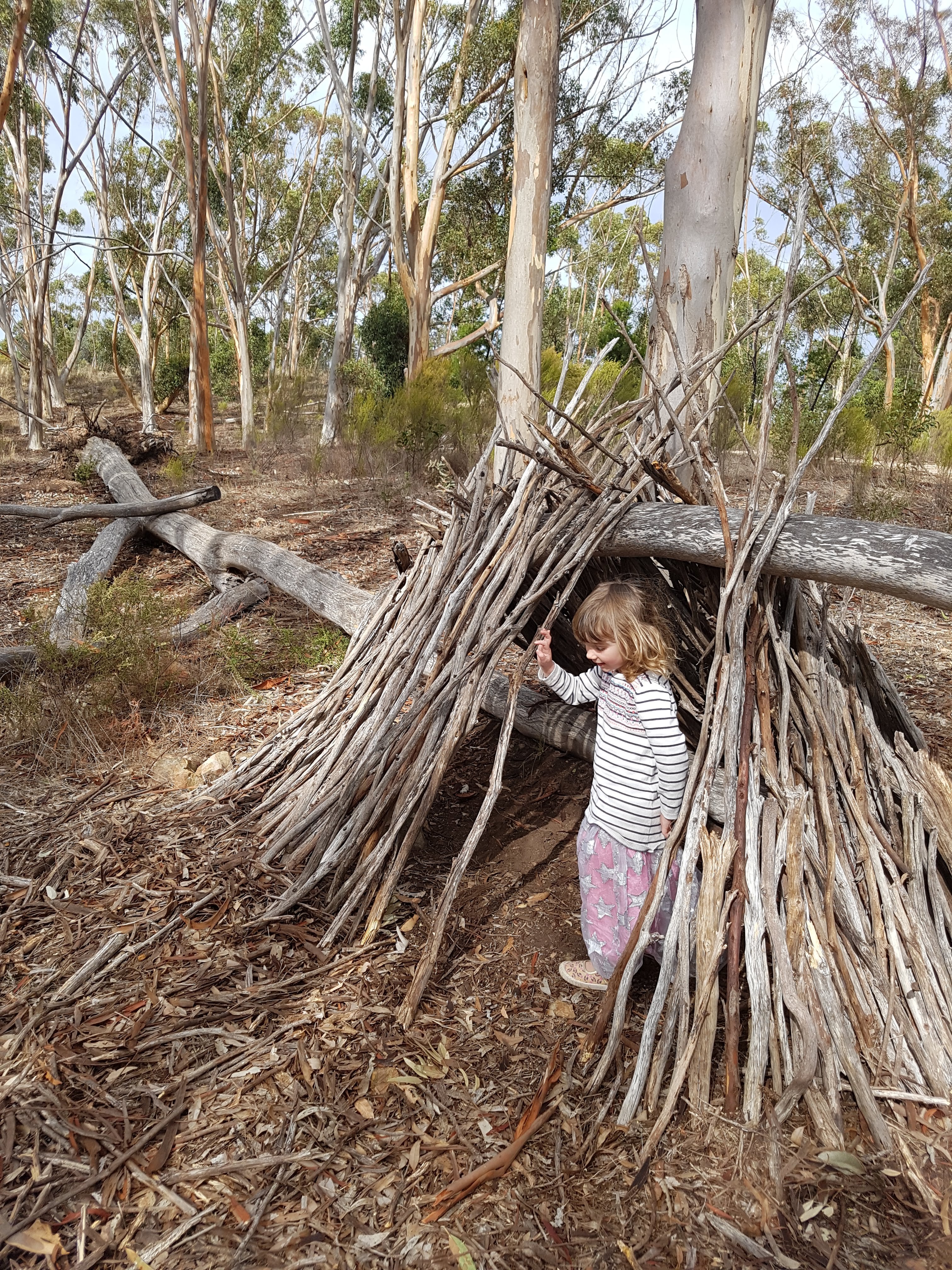 What: Come and join in a hunt for the colours of the bush. Help to discover how many different colours the bush has to offer. This is a free event for Nature Play Week and will be followed by a story about the bush. For details see the Facebook event page here.
What: Come and join in a hunt for the colours of the bush. Help to discover how many different colours the bush has to offer. This is a free event for Nature Play Week and will be followed by a story about the bush. For details see the Facebook event page here.
When: Thursday 12 April from 2:00 to 3:30 pm
Where: Kalimna Park near the cubby houses
Who: For children aged 4 to 6 years old and an accompanying adult
Bookings: Please book as numbers are limited. Please email tiffany.inglis@gmail.com
Cranes, Herons and Storks: a talk at the Castlemaine Field Naturalists Club Monthly meeting
Renowned photographer and author David Hollands wrote the classic book ‘Eagles Hawks and Falcons of Australia’ in the 1980s. He has written and provided photographs for many books on Australian birds, including kingfishers, owls and waders. David will be sharing his amazing photos and speaking about his latest book: Cranes, Herons and Storks of Australia.
The evening commences at 7.30 pm on Friday 13 April in the Fellowship Room, located behind the Uniting Church on Lyttleton St, Castlemaine (next door to the Castlemaine Art Museum). Members and visitors are all welcome to come along, and to stay for a light supper after the talk. This is a free event.
Tiny feathered visitor receives first aid
Posted on 5 April, 2018 by Tanya Loos
Many of our landholders and readers of this blog send us photographs of birds to identify, or animals that they are pleased to see on their properties and in their gardens. Last week, Robyn Patton, who lives south of Bendigo sent us photos of a bird that is ‘tiny and finch-like in size’.
The little creature had collided with a glass window and passed out from concussion. Robyn put the tiny bird in her dressing gown pocket.
The bird started to revive after a few hours, so she carefully placed the bird in a covered cat carrier. When the bird could perch well and seemed to be revived, Robyn set the little one free into the garden.
Have you guessed the species? It is a Striated Pardalote! We featured these stunning birds on a blog last year with Peter Turner’s wonderful photos ( see here). This rescued bird is very young, as it lacks the dark head and bold markings of adult pardalotes. My guess is that the little one had just left the nesting hollow, and unfortunately encountered a window on its first day!
Robyn’s quick thinking saved the pardalote from being eaten by an animal while unconscious. We suggest that a concussed bird be placed in a covered box such as a shoebox, with a tea towel or something soft in the bottom, and then left in a quiet room for a few hours to recover. The dressing gown pocket is very comfy, but a shoebox is an even quieter, safer spot for the bird to recover. The bird will not need water or food, just warmth, darkness and quiet. If it is still very ill, you may need to contact your local vet or wildlife shelter.
Robyn clearly loves her birds. Here she talks about the birds in her backyard:
‘They follow me around the veggie garden, checking out my every move. They make my heart smile and they’re great company. Yes, I actually talk to them on occasion. I keep telling them to eat only bad bugs, and make sure they have plenty of fresh water to drink and bathe in.’
Thanks for sending in the photos, Robyn – and we are thrilled this little bird recovered!
For information on how to prevent birds colliding with windows, please see the excellent link below.
https://www.allaboutbirds.org/why-birds-hit-windows-and-how-you-can-help-prevent-it/
Birdata App Workshop Friday 13 April
Posted on 29 March, 2018 by Tanya Loos
Andrew Silcocks from BirdLife Australia provides an introduction and practical demonstration of how to use online Birdata mapping and the smartphone app – at the beautiful Castlemaine Botanical Gardens.
This year, BirdLife Australia staff are travelling Victoria with a series of presentations and workshops on Birdata – how to use it, and more importantly, why to use it.
The information that BirdLife Australia takes from Birdata underpins their State of Australia’s Birds Reports, as well as population and species trends and distribution analyses. These analyses inform threatened species nominations, which in turn influence the government allocation of conservation dollars and resources to those species.
Andrew is the coordinator of Birdata at BirdLife Australia and he is keen to share the Birdata app with you! Tanya Loos from Connecting Country will also be on hand to discuss the close relationship between Birdata and the Connecting Country bird monitoring program.
When: Friday 13 April from 11am – 3pm
Where: Castlemaine Tea rooms, at the Castlemaine Botanical Gardens
What you need:
*Shoes and clothing appropriate for birdwatching outside
*Your binoculars (some will be provided)
*Your Birdata login – just sign up at https://birdata.birdlife.org.au/
*The Birdata app downloaded on your phone – available on Apple or Android
Bookings and enquiries to Tanya Loos tanya@connectingcountry.org.au or call our office on 5472 1594
Autumn workshop series – launch celebration 27 March 2018
Posted on 19 March, 2018 by Tanya Loos
On Tuesday 27 March we’re launching Connecting Country’s Autumn Workshop Series for 2018. The launch will be an informal gathering at the Hub Plot, Castlemaine, with drinks and nibbles. All of our friends and supporters are most welcome. And bring along your knowledge and competitive spirit for a nature quiz!
The theme for our autumn workshop series is Monitoring Healthy Habitats. We have a diverse series of events to inform and inspire you about habitat protection and local wildlife.
We’re pleased to be presenting these workshops together with our partner organisations:
- Bird monitoring, with BirdLife Australia
- Caring for large old trees, with Mount Alexander Shire Council.
- Nestboxes for wildlife, with Miles Geldard.
Launch celebration:
Tuesday 27 March from 5.00 – 7.00 pm
At the Hub Plot, behind 233 Barker St, Castlemaine
Please RSVP for catering purposes to tanya@connectingcountry.org.au or call 5472 1594
Click here for the Autumn Workshop Series flier, and stay tuned for more details on each workshop.
These workshops are kindly funded by the Wettenhall Environment Trust. This lauunch event is part of our community engagement program supported by Biodiversity Hubs funding from the Department of Environment, Land, Water and Planning.
Summer’s feathered migrants – Nature News November 7 2017
Posted on 20 November, 2017 by Tanya Loos
For this month’s Nature News, Newstead naturalist and photographer Geoff Park writes about the feathered migrants that are characteristic of our region in the summer months. This article was featured in the Midland Express on November 7, 2017.
Sacred Kingfishers are one of my favourite spring migrants, their loud ‘kek kek’ call may be heard anytime from late August around Newstead. The kingfishers return faithfully to favourite nesting sites along the Loddon River and in the surrounding forests. This species nests in earthen tunnels and tree hollows, with the first fledglings appearing around Christmas most years. Observers can delight in watching the kingfishers as they first stake out territories, refurbish nests and then commence feeding youngsters from late November onwards. The sight of Sacred Kingfishers bringing a selection of cicadas, yabbies, fish and reptiles to their hungry brood is one of the ‘sights of summer’.
My absolute favourite though is the Rainbow Bee-eater. This extraordinarily beautiful bird can be seen year round in northern Australia – but they are not the same individuals. Small flocks of Rainbow Bee-eaters make a twice yearly migration up and down the east coast, with some birds moving as far north as Papua New Guinea and New Caledonia. The birds we see around Newstead may well spend their winter on Cape York where they are replaced by international travellers during the northern summer, as the ‘Newstead’ individuals migrate south.
Rainbow Bee-eaters nest in small colonies, perhaps most notably near the Newstead Cemetery, but also at various locations along the Loddon River. The sound of the first trills of this species can be heard anytime from early October as they gather above their breeding grounds and make spectacular display flights. As spring progresses they descend to their tunnels, usually in a vertical bank of an eroded gully or riverbank and clean their nests in preparation for egg-laying. Not all nests sites are used each year, but some of these special spots must have been used for centuries by successive generations of magnificent ‘rainbowbirds’.
Other summer migrant specialties, such as the Square-tailed Kite, appear to be increasing in numbers. Flocks of woodswallows (Masked and White-browed Woodswallows) arrived on the first warm northerlies in October. We can also expect to see waders arrive from the northern Hemisphere, such as Red-necked Stints and Sharp-tailed Sandpipers. These tiny birds use Cairn Curran Reservoir (most years) and the Moolort Plains wetlands (if they are wet!) to fuel up before flying 10,000 kilometres back to their Siberian breeding grounds!
Look out too for the rarities that may visit each summer. Last year we had a Common Koel in Newstead and this year a spectacular small red honeyeater known as a Scarlet Honeyeater has been visiting the region in unprecedented numbers.
For more information contact Geoff Park at Natural Newstead www.geoffpark.wordpress.com
Boosting Bulokes project helps a diamond shine
Posted on 15 November, 2017 by Tanya Loos
Thanks to Connecting Country’s Boosting Bulokes and Diamond Firetails project there are now 1,200 more young Buloke plants in the western parts of the Mount Alexander region. These slow growing trees will eventually set seed and provide a much-needed food source for seed-eating birds such as Diamond Firetails and Common Bronzewing pigeons.
Buloke trees belong to the Casuarinaceae or Sheoak family and were once abundant across the region. Bulokes are so rare nowadays that they are listed as ‘threatened’ under the Victorian Flora and Fauna Guarantee Act 1988. We wanted to help bring this threatened species back into our local area. The Boosting Bulokes and Diamond Firetails project involved 78 landholders on 23 properties, Muckleford Landcare group and the kids and teachers of the Castlemaine Steiner School and Kindergarten.

Project coordinator Bonnie Humphreys with Lisa Hall from Castlemaine Steiner School – you can see the large robust guards in the background, as well as a host of enthusiastic kids and landholders!
Bonnie prepared a comprehensive fact sheet on Bulokes, covering their ecology, threats and importantly – how to plant and care for Bulokes! The sheet can be downloaded by clicking this link: Buloke-Factsheet-CCountry.
Diamond Firetails are attractive little finches whose numbers are declining in the region. Recent studies by Grace Goddard (unpublished PhD, Adelaide University) have shown that the Diamond Firetail relies heavily on the seeds from Sheoaks as a winter food source. Diamond Firetails also eat the seeds of exotic and native grasses. However, it’s the native grass seeds that are a superior food source. The Firetails also use the long grass stems to build their nests.
We can help our declining Diamond Firetail population, by planting:
* Native grass species such as spear grasses (from the Austrostipa and Rytidosperma genera).
* Sheoak trees – the more commonly occurring Drooping Sheoak ( Allocasuarina verticillata) and of course the Buloke ( Allocasuarina leuhmenii).
For a detailed (and somewhat technical) fact sheet on Grace Goddard’s Diamond Firetail studies click this link Diamond-Firetail-Diet-fact-sheet

A Diamond Firetail strikes a pose at the edge of a bird bath, while two Red-browed Finches look on. Thanks to Nick Schulz from Nuggetty for the great pic!
Caring for our Key Biodiversity Areas: new on ground works program
Posted on 1 November, 2017 by Tanya Loos
Connecting Country has been granted funding for a new on ground works project called ‘Caring for Key Biodiversity Areas in Central Victoria’. The special bird habitats of Clydesdale and Sandon are designated as Key Biodiversity Areas (KBAs) by BirdLife International and BirdLife Australia. The trigger species for these areas are the Diamond Firetail, Swift Parrot and Flame Robin.
The project is funded by the Victorian Government – Community and Volunteer Action Grants. In a nutshell, the project has three main components:
- Care and protection of native vegetation on private land, including actions such as supplementary revegetation, weed control and rabbit control. These actions will help enhance habitat for the trigger species for the Diamond Firetail, Swift Parrot and Flame Robin.
- Creation and installation of two attractive interpretative signs at popular parts of the Key Biodiversity areas, such as Rise and Shine Bushland Reserve, and Muckleford Nature Conservation Reserve.
- Two community events in 2018, such as a bird walk and sign launch!
The participating landholders have been contacted, and site visits will begin in early 2018.
Earlier this year, Connecting Country held a workshop in partnership with BirdLife Australia, to recruit bird survey volunteers known as ‘KBA guardians’ and provide training in how to complete an annual ‘Easter Heath Check’ form. You can read about that workshop here.
We are thrilled that this workshop generated the interest and the impetus for this grant.
There is also a very keen new group, coordinated by Friends of Muckleford Forest, which involves volunteers surveying 15 sites across the Muckleford KBA. These surveys are in preparation for the 2018 Easter Health Check. To read about Friends’ project, or volunteer, see the Friends website here.
- Learn about Key Biodiversity Areas by visiting the BirdLife Australia website: birdlife.org.au/KBA
Birds get a boost in the Goldfields region
Posted on 16 October, 2017 by Tanya Loos
By Tanya Loos, Connecting Country Monitoring and Engagement Coordinator
On Friday September 30, 2017, Connecting Country hosted an afternoon tea and planning meeting for the birders of the Castlemaine region. I presented some of the findings of the last six years of bird monitoring, and then the group had a discussion on the future of bird monitoring in the region. Last but not least, Fiona Blandford from BirdLife Australia gave a presentation on the merits of becoming a BirdLife Branch. It was a jam-packed afternoon, filled with energy and enthusiasm!
Preliminary findings and report
Connecting Country has been counting woodland birds since 2010 as part of our long term monitoring program. This has been undertaken by a staff member (such as myself or my predecessors) and has helped build a picture of bird species distribution across the landscape, especially in different habitats. This in-house monitoring has been quite comprehensive, but gaps still existed – so in 2014, we started a citizen science program to enlist the help of birders across the region. A whopping 20,000 bird records have been submitted to BirdLife Australia to date! The preliminary findings of the results of both programs may be found in this short report: Bird-Monitoring_Summary_Sept_2017
A more comprehensive update on this report to follow soon…
Bird monitoring in the region: banding together
We love our woodland birds in this region – there is the Connecting Country-led bird monitoring, and other initiatives as well. Lesley and Anne Perkins are continuing the bird monitoring that Ern and Lesley started some twenty years ago, with help from local birders: there are 15 sites in all. More recently, the Muckleford Key Biodiversity Area (KBA) monitoring group commenced monitoring their sites in the Muckleford forest. This group is ably coordinated by Geoff Nevill, and also has 15 sites.
We also wanted to discuss the other programs to ensure there was no double-up of sites and see if we could share methodology. After removing the double-up and including group sites – we calculated there are 84 sites being regularly monitored for birds across the region!
A follow-up blog post on the sites, survey methodology and other aspects of bird monitoring in our region coming soon…
A BirdLife Goldfields branch
Connecting Country has been an affiliate of BirdLife Australia since 2015, and we love our relationship – supporting each other’s events, and sharing data and expertise. Our nearest BirdLife Branches are in Ballarat, and to the north, in Echuca.
The Field Naturalist Clubs of Bendigo and Castlemaine, and more recently Connecting Country have filled the gap of bird activities in the region, such as the Annual Bird Count, and Swift Parrot Counts. But after discussions with key birders in the region, and with Fiona Blandford the Network Manager, we all feel it is time for a local branch!
Fiona has suggested BirdLife Goldfields – as the area covered will be Castlemaine and surrounds, including east to Baynton, south to Daylesford, up to just south of Bendigo, and to Maryborough in the west. Fiona gave us all an insight into the BirdLife model, and how branches work – and how they really can cater for the needs of the birders and communities they live in. And I am thrilled to say we already have enough interested people for a committee!
Please get in touch if you have any questions or would like to be involved in our growing bird monitoring project.
Call Tanya Loos, Monitoring and Engagement Coordinator, on 5472 1594 during work hours, or email tanya@connectingcountry.org.au
